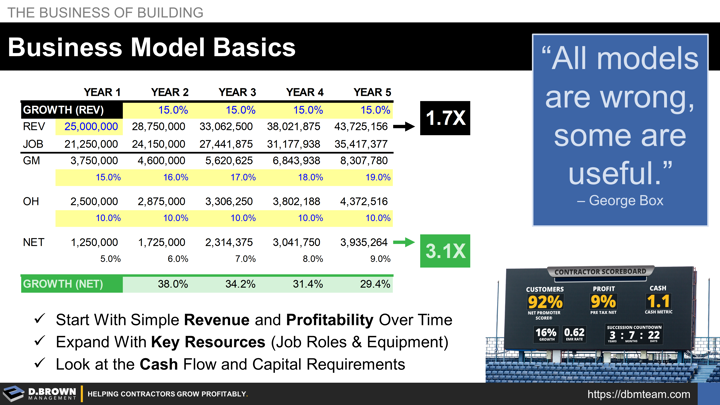The combination of strategy, systems, and structure must all work together in a viable business model.
Strategic choices are about where you are headed and how. These are the most highly leveraged choices the leadership of a construction business makes. These choices involve many people, but the ultimate decisions and accountability is with the CEO and board if applicable.
Supporting these strategic choices are your management systems. Everything is a process from how you win projects through how those projects are staffed and delivered to customers.
The management systems are largely a collection of tasks, meetings, and decisions organized to deliver consistent outcomes.
The people that do these tasks and make these decisions are organized in a structure ensuring that each layer is adding appropriate value to those on their team including allocation of resources, dissemination of information, quality control, quality assurance, and the handling of escalations plus the selection, training, and development of their team.
There is no one right business model that will work for every contractor. As George Box stated: "All models are wrong, some are useful."
Remember that your focus is to help you make critical business decisions.
- A business model is not a project bid, though it is related to your bids and project performance.
- A business model is not a budget, though it is related to your budgets.
- A business model is not your financial statements, though it is related to your financials.
What a business model does is show how everything fits together over time.
Sometimes it highlights the strategic question of "What must be true for this strategy to work?"
Start with the simple diagrams of how your business operates:
- Your contractor business model - both current and future-state.
- Your org chart - both current and future-state.
Typically, you will start with a relatively high-level view of Revenue and Profitability over time. A reasonable planning time-horizon is about 5 years. Possibly as short as 3 years or as far out as 10 years if you are entering a new market. Remember that this is not a detailed budget - just a model to test some basic assumptions.
Next you will likely look at key resources and metrics. For example, look at your cost estimating and scaling the team through several stages of growth.
- Owner doing most estimating (Stages 1 & 2)
- Project managers doing their own estimating (Stage 3)
- Consolidating estimating with a few dedicated estimators (Stages 3 & 4)
- Specializing estimating roles Chief Estimator, Senior Estimators, Estimators, and Take-Off Techs (Stages 5 & 6)
Along this journey, you expect your market strategy to take you into more negotiated work where your hit rate will move from 15% to 35%.
You expect larger average project sizes and new software will improve your estimating efficiency by 20%.
To build high quality estimators given the current talent market, you have developed a 1-year estimator training program. While this is improving the quality of the team, the actual production of new take-off technicians is 0% for their first 3 months while they are learning on prior projects then increases to about 25% for months 3-6, 50% for months 7-9, and 75% for months 10-12.
After that, they are comfortable capable of quantity take-off on 90% of what you do as a company and being developed for the estimating role over their second year in the program. The expected pull-through from those starting the program into estimators is 50%.
- How do you lay all these resources and their costs out over time in alignment with your revenue model above?
- How does this change your total estimating cost as a percentage of your revenue?
- How does this change your hiring plan?
This is just an example of one specific part of a model used to make a few decisions. A similar business model should be done for major equipment and technology investments.
Succession readiness at the talent level is important to build depending on your projected growth model and the timelines of all your key people. Effectively backfilling an experienced Superintendent or Project Manager can take years and that timeline only lengthens from there. Keep in mind the macro view of how long it takes to develop different levels of talent and the industry-wide shortage of talent.
Another critical model to build is the cash flow and capital required to support the other models including paying for an ownership transition if applicable.
As contractors, we know that just because it works on paper doesn't mean it will work in the field. It is the same with business models. Remember that the opposite is also true - if it won't work on paper, it will almost never work in the field.
You must develop basic business models while you are making your decisions about strategy, systems, and structure.

